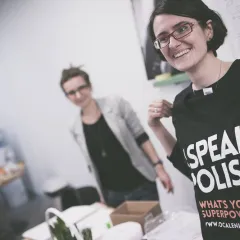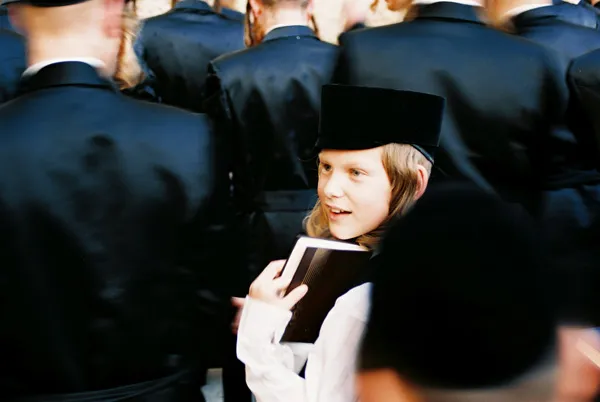“For a daughter, as for indigence, no one asks” – an ethnographic Regina Lientalowa noted this Jewish folk wisdom at the turn of the 20th century. It was believed that till the fifth month of pregnancy God may change the child’s sex, therefore women had to listen to the prayers in a synagogue for 31 days after conceiving and beg for that – she learned from the female inhabitants of shtetls – Jewish towns. Daughter is like a wolf, she wolfs down her dowry, and where five daughters are, all laughter dies – a researcher wrote down another wisdom from the collection of Jewish proverbs by I. Bernstein while she was preparing her monograph ‘Jewish Child’. Her studies of cultural context of parenthood and childhood in Jewish communities were published in 1907 and are still one of the main sources of knowledge about folk customs of this group.
Lilientalowa, born in 1875 in Zawichost, belonged to the assimilated circles and represented one of the first generations of Jewish women with strong intellectual ambitions. She realized them to a limited for women extent, attended lectures organized by the Flying University, where she became interested in ethnography. At first, she was interested in the Polish folklore, but over time she turned to her native culture, maybe under the influence of arising Jewish political movements, which started to boom at the turn of the 20th century. Her goal was to spread reliable knowledge about the Jews and their culture, and at the same time her scrupulous documentation was carried out from a conscious gender perspective, taking into account social expectations attributed to different sexes.
What strikes us in Lilentalowa’s texts is her clearly critical attitude towards the position of women in Jewish culture – she consequently shows how women were condemned, even before being born, and how they were marginalized throughout adolescence. At the same time, we notice her insightful descriptions of customs concerning children and the objection to circumcision, which she considered a cruelty against the most vulnerable beings. In such an attitude there’s a spirit of first-wave feminism, when women and children were always listed as the groups mostly harmed by patriarchy. It couldn’t have been different in a system which made motherhood the main goal of female life, therefore the rules in Jewish tradition pertaining to women and children were closely related to each other.
Religious pressure to produce offspring in Jewish folk culture developed with the emphasis not only on its quantity, but also quality – physical aspects other than sex were also decisive. Lilientalowa meticulously enumerates the warnings from the Talmud: a child will be born deaf-mute if the parents chat during the intercourse; lame – if they ‘turn it away’ (here one can be tempted for numerous interpretations); blind – if they look ‘there’; sickly – if the intercourse took place on the floor; and generally a failure if a husband forces his wife. Another, slightly more romantic advice concerning the beauty of a child ordered a wife to look upon her husband’s face during the insemination – then, the baby will be similar to him. However, provided that she won’t eat onions and radishes because those ‘coarse’ dishes were to give the baby a bad look.
After the birth of a child, most of the customs concerned the boys – the girls were only given a name – and most of the attention was focused on circumcision, which was fascinating also for Polish neighbours (Alina Cała writes about it in her book about a portrait of the Jews in Polish folk culture.) Before the circumcision there was a banquet for men, and the day of circumcision itself was celebrated by whole family – brit milah means inclusion of the infant into the Jewish community, where he’ll grow up to be a God-fearing boy. Protection against demons, whose power was commonly believed in at those times, included the period of pregnancy and infancy, mostly of boys, and the time when a woman was impure after giving birth – meaning the time she was restrained by some limitations in physical contact with her husband or in fulfilling religious commandments – was definitely shorter after giving birth to a son.
All further upbringing of children was held in the context of different roles attributed to both sexes. Lullabies, sung by mothers to their children in Jewish houses, were filled with dreams about the offspring’s future: a boy was usually a trained in Judaism sage, and a girl was a good and pious mother and wife (if those songs didn’t put the babies to sleep, a folk wisdom ordered to give them poppy brew, which with no doubt managed even with the biggest sleeplessness.) Daughters accompanied their mothers in house works from the youngest age while boys learned the prayers from their fathers and the Hebrew alphabet since they were three years old, so that they could later pore over the religious texts all day long - at the expense of physical development, which Lilientalowa points out. Intellectual development of a daughter wasn’t the object of her parents’ ambition because according to the scholars’ guideline: “Whoever teaches his daughter Torah teaches her obscenity.”
I have mixed feelings reading the extracts from the Jewish folklore. On the one hand, I laugh at the naivety of these beliefs, but on the other, at least part of the customs we know of had a long, religious tradition and was treated deathly serious. Certainly, as in case of any other community, it is often impossible to separate folklore from high culture. What for us seems to be superstitions and anachronic way of thinking, was one of the main sources of shaping national identity at the turn of the 20th century.
Today’s image of a Jew in Poland comes down to two pictures: a Hasid with sidelocks, dressed in a traditional cloak or an assimilated writer, the type of Julian Tuwim. It’s a shame that neither the Jewish history fans nor serious scholars are willing to reminisce about folk beliefs. We lose quite an intriguing part of the story because of that – not only from the Jewish but also Polish perspective. Since we are able to find common influences in our languages – the words such as tzimmes, mess, den or sluggard (from Jewish ‘misfortune’) – what kind of richness can still be hidden in the Polish folk culture, where perhaps the elements of the Ashkenazi Jews (pertaining to the Middle European Jews) folk culture are preserved, that cannot be found anywhere else?
Katarzyna Czerwonogóra
Translated by: Iwona Białek









